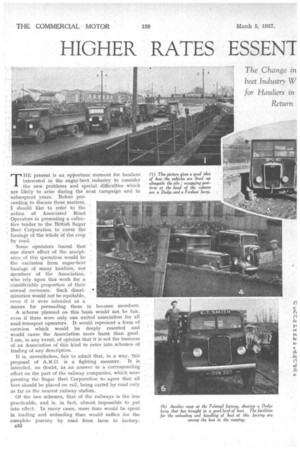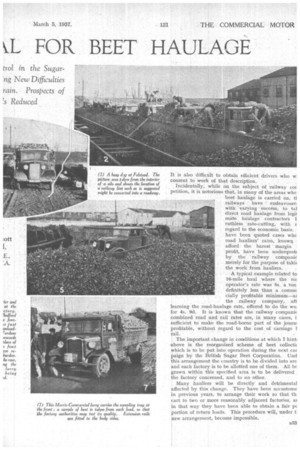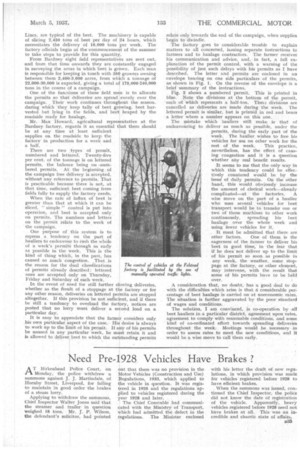HIGHER RATES ESSENT FOR BEET HAULAGE
Page 50

Page 51

Page 52

Page 53

If you've noticed an error in this article please click here to report it so we can fix it.
THE present is an opportune moment for hauliers interested in the •sugar-beet ,industry to consider . the new, problems and special difficulties which are likely to arise during the next campaign and in subsequent years. Before proceeding to discuss thee. matters, I Should like to refer to the action of , Associated Road Operators in Presenting a collective tender to the British Sugar Beet ' Corporation to _cover the haulage of the whole of the crop
by road. .
Some operators fearedthat one direct effect of the acceptance of this quotation would be the exclusion from sugar-beet haulage of many haulier' s, not members' of the Association', who rely upon this work for a.. considerable proportion of their annual revenues. Such discrimination would not be equitable, even if it vi'ere intended as a means for persuading them to become members.
A scheme planned on this basis would not be fair, even if there were only one united association for all road-transport operators. It would represent a form of coercion which would be deeply resented and would. cause, the Association more harm than good. I am, in any event, of opinion that it is not the business of an Association of this kind to enter into schemes of trading of any description.
It is, nevertheless, fair to admit that, in a way, this proposal of A.R.O. is a fighting measure. It is. intended, no doubt, as an answer to a corresponding effort on the part of the railway companies, which were pressing the Sugar Beet Corporation to agree that all beet should be placed on rail, being carted by road only as far as the nearest railway station.
Of the two schemes, that of the railways is the less practicable, and is, in. fact, almost impossible to put into effect. In many cases, more time would be spent in loading and unloading than would suffice for the complete journey by road from farm to factory.
n32 It is also difficult to obtain efficient drivers who w: consent to work of that description.
Incidentally, while on the subject of railway cot petition, it is notorious that, in many of the areas who: beet haulage is carried on, ft railways have • endeavoure. with varying success, to tal direct road haulage from legiA mate haulage contractors 1 ruthless rate-cutting, with r regard to the economic basis. have been quoted cases who road hauliers' rates, known afford the barest margin profit, have been underquot( by the railway companie merely for the purpose of takir the work from hauliers.
A typical example related to 16-mile haul where the roi operator's rate was 5s. a tondefinitely less than a comme• Cially profitable minimum—ai
• • the railway company, aft learning the ,road-haulage rate, offered to do the wo: for 4s. 9d. It is known that the railway companie combined road and rail rates are, in many cases, i sufficient to make the road-borne part of the journi profitable, without regard to the 'cost of carriage I rail.
The important change in conditions at which I hint, above is the reorganized scheme of beet collecti( which is to be put into operation during the next car paign by the British Sugar Beet Corporation. Und this arrangement the country is to be divided into are and each factory is to be allotted one of them. All be grown within this specified area is to be delivered the factory concerned, and to no other.
Many hauliers will be directly and detrimental affected by this change. They have been accustome in previous years, to arrange their work so that th cart to two or more reasonably adjacent factories, ai in that way they have been able to obtain a fair pr portion of return loads. This procedure will, under t new arrangement, become impossible.
It behoves all hauliers interested in the transport of sugar-beet to reconsider their rates, assessing them on the basis of one-way traffic (exclusive of a certain number of return loads of pulp), instead of, as hitherto, on the basis of a reasonable frequency of return loads.
Another element of more local interest relates to the factory at Albeat. The arrangements for unloading vehicles are threefold—by water jet, into chutes and on to a dump. The beet which is washed from the lorries travels directly into the factory and passes into production at once. That from the two chutes is conveyed forthwith into the factory by travelling belts.
It follows necessarily that the quantity of beet which is acceptable by these two methods is limited, according to the production capacity of the factory. Beet which is washed off the vehicles has first preference, and, generally speaking, one conveyor belt, in addition to a chute, suffices. Therefore, for the greater proportion of the time, only one chute is available to accept beet from road vehicles The management of the factory. does not like to have more beet than necessary placed on the dumps, because subsequent transport from the dump to the factory is required. The tendency is, therefore, for the management to hold up road vehicles and compelthem to deliver either by water jet or by one or other of the chutes. There is the further difficulty that the chutes themselves are inconveniently arranged and lorries Cannot tip into them from all four sides.
The result is congestion, and it is no uncommon occurrence for a lorry to be delayed for five hours from the time of entering the factory gates until the time of leaving them. if it be recalled that that machine has probably brought in no more than 4 tons of beet at a maximum rate of 3s. per ton, the effect of such delay upon the profit-earning prospects of beet haulage to Allscot is immediately apparent. There is, indeed, no profit-earning capacity in work of this description.
I understand that A.R.O. and possibly the Commercial Motor Users Association are negotiating with the Sugar Beet Corporation with the object of discovering whether these conditions can be improved. As I see it, one of the difficulties is that the capacity of the Allscot factory is small as compared with most of the factories, so that the more elaborate provisions with which hauliers are familiar at other beet factories might prove somewhat expensive in relation to the output. I am sure that all parties to the discussion would welcome constructive suggestions from haulage contractors directly concerned . and personally familiar with the conditions.
. Most beet factories were built in accordance with condi-. tions prevailing upwards of 10 years ago. They were planned to accept 66 per cent, of deliveries by rail and 33 per cent, by road. In the first year, the percentage deliveries were as represented by those figures. It is the growth in popularity of road transport, its Proved suit
ability for the work, which has effected such a change in conditions. Tip to the time of my visit to Bardney, 78 per cent. of the deliveries had come by road, and at Felstcad, over 80 per cent, had arrived in that fashion.
At both Bardney and Felstead the factory officials are giving serious consideration to modifying the conditions so as further to facilitate the influx of beet by road.
At Felstead, Mr. Sheaves, the agricultural representative, tells me that a suggestion has been made that one of the railway delivery sidings, which runs above the middle of a large silo, should be converted into a roadway, planned so that road vehicles could he unloaded from both sides, as is the case with railway wagons.
A certain amount of congestion still prevails at most sugar-beet factories. Not all of this, however, is due to inadequacy of arrangements to accept road-delivered beet. Some of it is undoubtedly due to the way in which hauliers themselves tackle the problem. That there should be a long queue of vehicles waiting for . the factory gates to open in the morning, for example, is something for which only the hauliers themselves can be blamed. I have examined the permit system which is in force at most of the principal factories and it seems that if it were more intèlligently used by growers and hauliers, deliveries. Would be more even and there would be less delay.
A good deal of trouble is taken to ensure that these permits are issued in such a way that the needs of the factory are met evenly throughout the campaign. The arrangements for road transport at most factories are such that if the vehicles arrived in a correspondingly even flow, there would be practically no waiting.
The methods at Bardney,
Lines, are typical of the best. The machinery is capable of slicing 2,450 tons of beet per day of 4 hours, which necessitates the delivery of 16,000 tons per week. The factory officials begin at the commencerner t of the summer to take steps to provide for this quantit
From Bardney eight field representativ s are sent out, and from that time onwards they are co stantly engaged in surveying the areas in which beet is gr wn. Each "man is responsible for keeping in touch with 35 growers owning between them 2,400-3,000 acres, from which a tonnage of 22,000-30,000 is expected, giving a total o 175,000-240,000 tons in the course of a campaign.
One of the funztions of these field mein is to allocate the permits so that deliverier are spread evenly over the campaign. . Their work continues throng out the season. during which they keep tally of beet gr wing, beet harvested but lying in the fields, and beet heaped by the roadside ready for haulage.
Mr. Max Howard, agricultural repre Bardney factory, regards it as essential t be at any time at least sufficient supplies on the roadside to keep the factory in production for a week and a half.
There are two types of permit, numbered and lettered. Twenty-five per cent, of the tonnage is on lettered permits, the balance being on .numbered permits. At the beginning , of the campaign free delivery is accepted, without any reference to permits. That is practicable because there is not, at that time, sufficient beet coming from fields fully to supply the factory needs.
When the rate of influx of beet is greater than that at which it can be " simple " control is put into operation, and beet is accepted only on permits. The numbers and letters on the permit relate to the week of the campaign.
One purpose of this system is to repress a tendency on the part of hauliers to endeavour to rush the whole of a week's permits through as early as possible in the week. This is the kind of thing which, in the past, has caused so much congestion. That is the reason for the dual classifications of permits already described: lettered ones are accepted only on Thursday, Friday and Saturday of eath week.
In the event of need for still further s whether as the result of a stoppage at t any other reason, deliveries on lettered pe altogether. If this provision be not sufftc be still a tendency to overload the fac posted that no lorry must deliver a se particular day.
It is easy to appreciate that the farme his own particular aspect of the case.. Hi to work up to the limit of his permit. If a be unused in any particular week, he m is allowed to deliver beet to which the out relate only towards the end of the campaign, when supplies begin to dwindle, The factory goes to considerable trouble to explain matters to all concerned, issuing separate instructions to farmers and to haulage contractors. The farmer receives his communication and advice, and, • in fact, a full explanation of the permit control, with a warning of the possibility of just such delays with his permits as I have described. The letter and permits are enclosed in an envelope bearing on one side particulars of the permits, as shown in Fig. I. On the reverse of the envelope is a brief summary of the instructions.
Fig. 2 shows a numbered permit. This is printed in blue. Note the divisions at the bottom of the permit, each of which represents .a half-ton, These divisions are cancelled as deliveries are made during the week. The lettered permit is similar, but is printed in red and bears number appears on this one.
which hauliers still make is that of deliver as much as possible, under the permits, during the early part of the week. The haulier wishes to free his vehicles for use on other workfor the rest of the week. This practice, nevertheless, has the effect of causing congestion and it is a question whether any real benefit results.
It seems to me that the only way in which this tendency could be effec, lively countered would be by the issue of daily permits. On the other hand, this would obviously increase the amount of clerical work—already complicated—at the factories. A wise move on the part of a haulier who uses several vehicles for beet transport would be to transfer one or two of those machines to other work continuously, spreading his beet haulage over the whole week and using fewer vehicles for it.
It must be admitted that there are other factors. One of them is the eagerness of the farmer to deliver his beet in good time, in the fear that if he does not deliver up to the limit of his permit so soon as possible in any week, the weather, some stoppage at the factory, or other element, may intervene, with the result that some of his permits have to be held over.
A consideration that, no doubt,has a good deal to do with the difficulties which arise is that a considerable percentage of beet haulage is carried on at uneconomic rates. The situation is further aggravated, by the poor standard of wages and conditions..
The solution, I am convinced, is co-operation by all beet hauliers in• a particular district, agreement upon rates, agreement to comply with reasonable conditions, and some kind of co-ordiriated effort towards spreading deliveries throughout the week. Meeting's would be necessary : in order to assess rates to meet the new conditions, and it would be a wise move to Call them early.




































































































